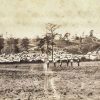calsfoundation@cals.org
Military Farm Colonies (Arkansas Delta)
As the Federal army moved across Arkansas during the Civil War, thousands of newly freed slaves attached themselves to military units and eventually began to amass in Union strongholds. Helena (Phillips County) and Pine Bluff (Jefferson County) were just two of the towns where Union commanders struggled to provide for this massive influx of refugees.
As more freedmen arrived at Helena after it fell to Union forces in 1862, military officers worked to alleviate the strain these civilians put on the supply lines. Eventually, a program that saw some success in Tennessee and Mississippi was adopted by the commanders at Helena. Realizing that the freedmen were an untapped source of labor, Union officers east of the Mississippi River leased abandoned farms and confiscated plantations to Unionists who, in turn, hired freedmen to work the properties. This provided a way for the newly freed slaves to provide for themselves while earning a wage and not using supplies intended for the army.
The program was extended to the Helena area in April 1863, but it was not fully implemented the first year. In October 1863, the U.S. Treasury Department took control of the program and established three offices that controlled the leases in the state. Offices at Little Rock (Pulaski County) and Helena controlled lands near those cities, while an office located at Skipworth Landing, Louisiana, was responsible for land in extreme southeastern Arkansas. Eventually, plantations operated near Helena, in central Arkansas, near Pine Bluff, and in Chicot County, as well as other locations in eastern Arkansas.
In January 1864, the Treasury Department began to distribute land to lessees, many of whom almost immediately began to complain about the wages required to be paid to the freedmen, which were higher than when the program operated under the army. President Abraham Lincoln responded by returning the program to army control, and the army eventually took responsibility for the care of the freedmen while the Treasury Department continued to handle the leases. Confusion about which system should be used continued to exist in the state for much of the remainder of the war.
By the end of 1864, at least 100 plantations in the state, mostly leased by white northerners, were using the labor of freedmen. Some plantations were leased by former slaves, who operated them in much the same fashion as did the white planters. Other areas continued to operate under the management of the original owners, who now paid their former slaves as workers, although most physically fit freedmen joined the army rather than serve as laborers.
A system of home-farms was used to register people who wanted work. Planters needing labor obtained able-bodied workers from these home-farms, while the infirm and elderly typically remained on the farms and worked the land. Workers received wages based on their classification on a three-tier system that took into account their age and gender. Lessees using the treasury system were required to provide workers one-half of their wages monthly, and workers were allowed to accept their wages in cash, food, or other supplies. Employers using the army system paid their workers less but were required to provide food and clothing and did not subtract these items from the wages earned by the laborers. Other plantations used a share system that awarded a percentage of the crop at the end of the season to the workers. In addition to workers receiving wages, the new system had another major difference from the old system of slavery: workers could not be whipped.
Plantations operated near Union outposts but remained under the possible threat of attack by both Confederate and irregular forces. Most Confederate units were located in southern Arkansas after the fall of Little Rock, but some cavalry units did operate north of the Arkansas River, especially during the summer of 1864. Two forts were constructed near Helena to protect the plantations in that area from enemy forces. Small Federal forces were posted at some plantations to protect them from enemy action. Attacks on plantations near Helena occurred on August 1 and 3, 1864, including the Skirmish at Lamb’s Plantation. In these attacks, Confederate forces destroyed at least three plantations, captured around 300 workers, and killed a number of soldiers and employees. All of the supplies at the plantations were stolen or confiscated, and many of the freedmen who were not killed or captured fled to Helena. These attacks severely disrupted the agricultural operations in the area, but the crops were not destroyed, allowing lessees to harvest their investments a few months later.
Friction between workers and lessees was a continual problem. Planters complained that the freedmen worked too slowly and spent much less time in the fields as compared to when they were slaves. The freedmen argued that they were physically mistreated, including being struck by lessees. Some freedmen were forced off the land at the end of the seasons, which meant that they technically broke their contracts and were not eligible to receive any compensation for their labor. Others had large amounts deducted from their wages not only for food and other goods, but as penalties for not working enough hours. Some freedmen actually owed money at the end of their contract.
The Federal government sought to understand why the system failed so many freedmen in 1864 but did not determine a single cause for the multitude of problems. The number of plantations leased in 1865 dropped from a high of 100 to forty-one. A combination of worker problems and Confederate activity could be blamed for some of the drop, but many lessees did not know what the end of the war might bring and did not wish to make the investments required to ensure a large crop when the plantations might be returned before it could be harvested. More pre-war landowners returned to their plantations and began to raise crops, while control of the labor contracts came under the control of the Freedmen’s Bureau in March 1865. This agency encouraged former slaves to work for shares, foreshadowing the sharecropping system that would spread across the South in the years to come.
With the transfer of the program from the army to the Freedmen’s Bureau, the need for military protection came to an end. While the military farm colonies operated for only two years, they did have an impact on the Arkansas economy and the safety of freedmen, though not always for the best.
For additional information:
Carmichael, Maude. “Federal Experiments with Negro Labor on Abandoned Plantations in Arkansas, 1862–1865.” Arkansas Historical Quarterly 1 (June 1942): 101–116.
Moneyhon, Carl. “From Slave to Free Labor: The Federal Plantation Experiment in Arkansas.” Arkansas Historical Quarterly 53 (Summer 1994): 137–160.
Wenzel, Carol. “Freedmen’s Farm Letters of Samuel and Louisa Mallory to ‘our absent but ever remembered boy’ in McHenry County, Illinois.” Journal of the Illinois State Historical Society (1908–1984) 73 (Autumn 1980): 162–176.
David Sesser
Henderson State University





 ACWSC Logo
ACWSC Logo 



Comments
No comments on this entry yet.